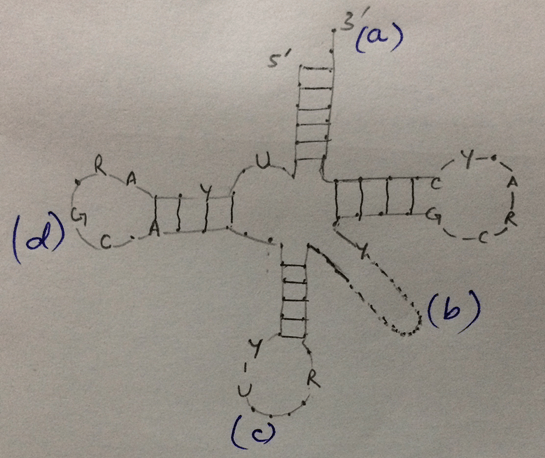This set of Cell Biology Multiple Choice Questions & Answers (MCQs) focuses on “Gene Expression – Genetic Code Decoding”.
1. Translation is the process of _____________________
a) mRNA synthesis
b) tRNA synthesis
c) protein synthesis
d) nucleic acid synthesis
View Answer
Explanation: Translation is the process of protein synthesis. Proteins are synthesized by decoding the sequence of genes with the help of some adaptor molecules and intermediaries such a transfer and messenger RNAs.
2. Transfer RNAs decode the information present in __________________
a) mRNA
b) siRNA
c) miRNA
d) rRNA
View Answer
Explanation: Transfer RNAs have the role of decoding the information present in the messenger RNA molecule (mRNA) and direct the assembly of amino acids on a polypeptide chain.
3. Transfer RNA linked to an amino acid is called _____________
a) a-tRNA
b) amino-tRNA
c) tRNA
d) aa-tRNA
View Answer
Explanation: Transfer RNA linked to an amino acid is termed as aa-tRNA. Transfer RNAs have the dual function of carrying an amino acid (as aa-tRNA) and recognizing a particular codon in the messenger RNA.
4. When was the first base sequence of a transfer RNA reported?
a) 1935
b) 1945
c) 1955
d) 1965
View Answer
Explanation: Robert Holley of Cornell University, after seven years of work in 1965 reported the first base sequence of a yeast transfer RNA. This tRNA composed of 77 nucleotides and carried the amino acid alanine.
5. Which region of the tRNA molecule is highly variable?

a) a
b) b
c) c
d) d
View Answer
Explanation: The greatest variability among the diverse transfer RNA molecules occurs in the variability arm. It is 4 to 21 nucleotides in length, located amidst the T-arm and anticodon.
6. In the below figure of a transfer RNA, which is the site of attachment for an amino acid?

a) a
b) b
c) c
d) d
View Answer
Explanation: The amino acid attaches at the 3’ end of a transfer RNA molecule, whereas the opposite end bears the anticodon. The region of 3’ and downwards is called the amino-acid acceptor arm.
7. The length of tRNA molecules is ________________ nucleotides.
a) 20-30
b) 50-70
c) 73-93
d) 83-93
View Answer
Explanation: All the transfer RNA molecules are roughly the same length i.e. between 73 to 93 nucleotides. All the tRNAs also have a significant percentage of posttranscriptionally modified bases.
8. All mature tRNAs have the sequence CCA at their 3’ end.
a) True
b) False
View Answer
Explanation: All mature transfer RNA molecules have the characteristic trinucleotide sequence CCA at their 3’ end. This sequence is encoded in the tRNA gene in prokaryotes while it is added enzymatically in eukaryotes.
9. The part of tRNA that interacts with the codon of mRNA is termed as __________
a) Anticodon
b) T-arm
c) D-arm
d) V-arm
View Answer
Explanation: The part of tRNA that participates in complementary interaction with the codon of messenger RNA is called anticodon, located in the middle loop of tRNA molecule.
10. The “wobble hypothesis” was proposed by ______________________
a) James Watson
b) Barbara McClintock
c) Thomas Morgan
d) Francis Crick
View Answer
Explanation: The “wobble hypothesis” was proposed by Francis Crick in his view that transfer RNA can recognize more than one codon. In the hypothesis, he proposed that two codons that differ only in the third position can use the same tRNA for protein synthesis.
11. The enzyme aminoacyl-tRNA synthetase is responsible for linking ____________________________
a) amino acid to tRNA
b) amino acid to mRNA
c) carboxyl to tRNA
d) carboxyl to mRNA
View Answer
Explanation: The enzyme aminoacyl-tRNA synthetase links a specific amino acid to the 3’ end of tRNA. Organisms usually contain twenty aminoacyl-tRNA synthetase enzymes.
Sanfoundry Global Education & Learning Series – Cell Biology.
To practice all areas of Cell Biology, here is complete set of 1000+ Multiple Choice Questions and Answers.
If you find a mistake in question / option / answer, kindly take a screenshot and email to [email protected]
- Check Cell Biology Books
- Check Biotechnology Books
- Apply for Biotechnology Internship
- Practice Biotechnology MCQs
